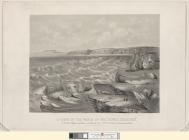The Royal Charter
Items in this story:
The Royal Charter
On 25 October 1859 the Royal Charter, a steam and sailing ship, bound for Liverpool was sunk off the coast of Anglesey in a violent storm.
The 2,700 ton vessel was nearing the end of its long voyage from Melbourne, Australia with hundreds of passengers and crew and gold worth an estimated £320,000. In the Irish Sea, the Royal Charter sailed into the worst storm of that century with fierce winds and giant waves making their voyage treacherous. Upon reaching the coast of north Wales, the pilot from Liverpool was called but was unable to board the ship in the rough seas. The captain decided to take shelter in the Moelfre Bay rather than risk making his way to Liverpool unaided.
Shipwreck
In Moelfre Bay, it is reported that 18 metre-high waves battered the Royal Charter, causing its anchor to break and send the ship crashing into the rocks. The ship split in two and the passengers and crew were swept into the tumultuous waves. It is not certain how many lives were lost but the ship’s passenger log suggests that there were some 388 passengers and 110 crew onboard. Of those, 459 lost their lives in the sea off Moelfre, some were crushed against the rocks and others were said to have drowned from the weight of gold in their pockets. Of the survivors, 21 were passengers and 18 were crew, all were men.
The storm that caused the Royal Charter disaster was also responsible for another 110 shipwrecks along the Welsh coastline.
Today, there is a memorial to the disaster on the Anglesey Coastal Path above where the ship struck the rocks and the graves of many who lost their lives are in St Gallgo’s Church in nearby Llanallgo.

